- Home
- E. B. White
The Elements of Style Page 3
The Elements of Style Read online
Page 3
Use the simple personal pronoun as a subject.
Blake and myself stayed home
Blake and I stayed home.
Howard and yourself brought the lunch, I thought.
Howardand you brought the lunch, I thought.
The possessive case of pronouns is used to show ownership. It has two forms: the adjectival modifier, your hat, and the noun form, a hat of yours.
The dog has buried one of your gloves and one of mine in the flower bed.
Gerunds usually require the possessive case.
Mother objected to our driving on the icy roads.
A present participle as a verbal, on the other hand, takes the objective case.
They heard him singing in the shower.
The difference between a verbal participle and a gerund is not always obvious, but note what is really said in each of the following.
Do you mind me asking a question?
Do you mind my asking a question?
In the first sentence, the queried objection is to me, as opposed to other members of the group, asking a question. In the second example, the issue is whether a question may be asked at all.
11. A participial phrase at the beginning of a sentence must refer to the grammatical subject.
Walking slowly down the road, he saw a woman accompanied by two children.
The word walking refers to the subject of the sentence, not to the woman. To make it refer to the woman, the writer must recast the sentence.
He saw a woman, accompanied by two children, walking slowly down the road.
Participial phrases preceded by a conjunction or by a preposition, nouns in apposition, adjectives, and adjective phrases come under the same rule if they begin the sentence.
On arriving in Chicago, his friends met him at the station.
On arriving in Chicago, he was met at the station by his friends.
A soldier of proved valor, they entrusted him with the defense of the city.
A soldier of proved valor, he was entrusted with the defense of the city.
Young and inexperienced, the task seemed easy to me.
Young and inexperienced, I thought the task easy.
Without a friend to counsel him, the temptation proved irresistible
Without a friend to counsel him, he found the temptation irresistible.
Sentences violating Rule 11 are often ludicrous:
Being in a dilapidated condition, I was able to buy the house very cheap.
Wondering irresolutely what to do next, the clock struck twelve.
* * *
II - Elementary Principles of Composition
12. Choose a suitable design and hold to it.
A basic structural design underlies every kind of writing. Writers will in part follow this design, in part deviate from it, according to their skills, their needs, and the unexpected events that accompany the act of composition. Writing, to be effective, must follow closely the thoughts of the writer, but not necessarily in the order in which those thoughts occur. This calls for a scheme of procedure. In some cases, the best design is no design, as with a love letter, which is simply an outpouring, or with a casual essay, which is a ramble. But in most cases, planning must be a deliberate prelude to writing. The first principle of composition, therefore, is to foresee or determine the shape of what is to come and pursue that shape.
A sonnet is built on a fourteen-line frame, each line containing five feet. Hence, sonneteers know exactly where they are headed, although they may not know how to get there. Most forms of composition are less clearly defined, more flexible, but all have skeletons to which the writer will bring the flesh and the blood. The more clearly the writer perceives the shape, the better are the chances of success.
13. Make the paragraph the unit of composition.
The paragraph is a convenient unit; it serves all forms of literary work. As long as it holds together, a paragraph may be of any length—a single, short sentence or a passage of great duration.
If the subject on which you are writing is of slight extent, or if you intend to treat it briefly, there may be no need to divide it into topics. Thus, a brief description, a brief book review, a brief account of a single incident, a narrative merely outlining an action, the setting forth of a single idea—any one of these is best written in a single paragraph. After the paragraph has been written, examine it to see whether division will improve it.
Ordinarily, however, a subject requires division into topics, each of which should be dealt with in a paragraph. The object of treating each topic in a paragraph by itself is, of course, to aid the reader. The beginning of each paragraph is a signal that a new step in the development of the subject has been reached.
As a rule, single sentences should not be written or printed as paragraphs. An exception may be made of sentences of transition, indicating the relation between the parts of an exposition or argument.
In dialogue, each speech, even if only a single word, is usually a paragraph by itself; that is, a new paragraph begins with each change of speaker. The application of this rule when dialogue and narrative are combined is best learned from examples in well-edited works of fiction. Sometimes a writer, seeking to create an effect of rapid talk or for some other reason, will elect not to set off each speech in a separate paragraph and instead will run speeches together. The common practice, however, and the one that serves best in most instances, is to give each speech a paragraph of its own.
As a rule, begin each paragraph either with a sentence that suggests the topic or with a sentence that helps the transition. If a paragraph forms part of a larger composition, its relation to what precedes, or its function as a part of the whole, may need to be expressed. This can sometimes be done by a mere word or phrase (again, therefore, for the 'tame reason) in the first sentence. Sometimes, however, it is expedient to get into the topic slowly, byway of a sentence or two of introduction or transition.
In narration and description, the paragraph sometimes begins with a concise, comprehensive statement serving to hold together the details that follow.
The breeze served us admirably.
The campaign opened with a series of reverses.
The next ten or twelve pages were filled with a curious set of entries.
But when this device, or any device, is too often used, it becomes a mannerism. More commonly, the opening sentence simply indicates by its subject the direction the paragraph is to take.
At length I thought I might return toward the stockade.
He picked up the heavy lamp from the table and began to explore.
Another flight of steps, and they emerged on the roof.
In animated narrative, the paragraphs are likely to be short and without any semblance of a topic sentence, the writer rushing headlong, event following event in rapid succession. The break between such paragraphs merely serves the purpose of a rhetorical pause, throwing into prominence some detail of the action.
In general, remember that paragraphing calls for a good eye as well as a logical mind. Enormous blocks of print look formidable to readers, who are often reluctant to tackle them. Therefore, breaking long paragraphs in two, even if it is not necessary to do so for sense, meaning, or logical development, is often a visual help. But remember, too, that firing off many short paragraphs in quick succession can be distracting. Paragraph breaks used only for show read like the writing of commerce or of display advertising. Moderation and a sense of order should be the main considerations in paragraphing.
14. Use the active voice.
The active voice is usually more direct and vigorous than the passive:
I shall always remember my first visit to Boston.
This is much better than
My first visit to Boston will always be remembered by me.
The latter sentence is less direct, less bold, and less concise. If the writer tries to make it more concise by omitting "by me."
My first visit to Boston will always be remembered,
it becomes indefinite: is it the writer or some undisclosed person or the world at large that will always remember this visit?
This rule does not, of course, mean that the writer should entirely discard the passive voice, which is frequently convenient and sometimes necessary.
The dramatists of the Restoration are little esteemed today.
Modern readers have little esteem for the dramatists of the Restoration.
The first would be the preferred form in a paragraph on the dramatists of the Restoration, the second in a paragraph on the tastes of modern readers. The need to make a particular word the subject of the sentence will often, as in these examples, determine which voice is to be used.
The habitual use of the active voice, however, makes for forcible writing. This is true not only in narrative concerned principally with action but in writing of any kind. Many a tame sentence of description or exposition can be made lively and emphatic by substituting a transitive in the active voice for some such perfunctory expression as there is or could be heard.
There were a great number of dead leaves lying on the ground.
Dead leaves covered the ground.
At dawn the crowing of a rooster could be heard.
The cock's crow came with dawn.
The reason he left college was that his health became impaired.
Failing health compelled him to leave college.
It was not long before she was very sorry that she had said what she had.
She soon repented her words.
Note, in the examples above, that when a sentence is made stronger, it usually becomes shorter. Thus, brevity is a by-product of vigor.
15. Put statements in positive form.
Make definite assertions. Avoid tame, colorless, hesitating, noncommittal language. Use the word not as a means of denial or in antithesis, never as a means of evasion.
He was not very often on time.
He usually came late.
She did not think that studying Latin was a sensible way to use one's time.
She thought the study of Latin a waste of time.
The Taming of the Shrew is rather weak in spots. Shakespeare does not portray Katharine as a very admirable character, nor does Bianca remain long in memory as an important character in Shakespeare's works.
The women in The Taming of the Shrew are unattractive. Katharine is disagreeable, Bianca insignificant.
The last example, before correction, is indefinite as well as negative. The corrected version, consequently, is simply a guess at the writers intention.
All three examples show the weakness inherent in the word not. Consciously or unconsciously, the reader is dissatisfied with being told only what is not; the reader wishes to be told what is. Hence, as a rule, it is better to express even a negative in positive form. not honest - dishonest
not important - trifling
did not remember - forgot
did not pay any attention to - ignored
did not have much confidence in - distrusted
Placing negative and positive in opposition makes for a stronger structure.
Not charity, but simple justice.
Not that I loved Caesar less, but that I loved Rome more.
Ask not what your country can do for you—ask what you can do for your country.
Negative words other than not are usually strong.
Her loveliness I never knew / Until she smiled on me.
Statements qualified with unnecessary auxiliaries or conditionals sound irresolute.
If you would let us know the time of your arrival, we would be happy to arrange your transportation from the airport.
If you will let us know the time of your arrival, we shall be happy to arrange your transportation from the airport.
Applicants can make a £ood impression by being neat and punctual.
Applicants will make a good impression if they are neat and punctual.
Plath may be ranked among those modern poets who died young.
Plath was one of those modern poets who died young.
If your every sentence admits a doubt, your writing will lack authority. Save the auxiliaries would, should, could, may, might, and can for situations involving real uncertainty.
16. Use definite, specific, concrete language. Prefer the specific to the general, the definite to the vague, the concrete to the abstract.
A period of unfavorable weather set in.
It rained every day for a week.
He showed satisfaction as he took possession of his well-earned reward.
He grinned as he pocketed the coin.
If those who have studied the art of writing are in accord on any one point, it is this: the surest way to arouse and hold the reader's attention is by being specific, definite, and concrete. The greatest writers—Homer, Dante, Shakespeare— are effective largely because they deal in particulars and report the details that matter. Their words call up pictures.
Jean Stafford, to cite a more modern author, demonstrates in her short story "In the Zoo" how prose is made vivid by the use of words that evoke images and sensations:
… Daisy and I in time found asylum in a small menagerie down by the railroad tracks. It belonged to a gentle alcoholic ne'er-do-well, who did nothing all day long but drink bathtub gin in rickeys and play solitaire and smile to himself and talk to his animals. He had a little, stunted red vixen and a deodorized skunk, a parrot from Tahiti that spoke Parisian French, a woebegone coyote, and two capuchin monkeys, so serious and humanized, so small and sad and sweet, and so religious-looking with their tonsured heads that it was impossible not to think their gibberish was really an ordered language with a grammar that someday some philologist would understand.
Gran knew about our visits to Mr. Murphy and she did not object, for it gave her keen pleasure to excoriate him when we came home. His vice was not a matter of guesswork; it was an established fact that he was half-seas over from dawn till midnight. "With the black Irish," said Gran, "the taste for drink is taken in with the mother's milk and is never mastered. Oh, I know all about those promises to join the temperance movement and not to touch another drop. The way to Hell is paved with good intentions."*
*Excerpt from "In the Zoo" from Bad Characters by Jean Stafford. Copyright © 1964 by Jean Stafford. Copyright renewed © 1992 by Sora Cosgrove. Reprinted by permission of Farrar, Straus & Giroux, Inc. Also copyright © 1969 by Jean Stafford; reprinted by permission of Curtis Brown, Ltd.
If the experiences of Walter Mitty, of Molly Bloom, of Rabbit Angstrom have seemed for the moment real to countless readers, if in reading Faulkner we have almost the sense of inhabiting Yoknapatawpha County during the decline of the South, it is because the details used are definite, the terms concrete. It is not that every detail is given—that would be impossible, as well as to no purpose— but that all the significant details are given, and with such accuracy and vigor that readers, in imagination, can project themselves into the scene.
In exposition and in argument, the writer must likewise never lose hold of the concrete; and even when dealing with general principles, the writer must furnish particular instances of their application.
In his Philosophy of Style, Herbert Spencer gives two sentences to illustrate how the vague and general can be turned into the vivid and particular:
In proportion as the manners, customs, and amusements of a nation are cruel and barbarous, the regulations of its penal code will be severe.
In proportion as men delight in battles, bullfights, and combats of gladiators, will they punish by hanging, burning, and the rack.
To show what happens when strong writing is deprived of its vigor, George Orwell once took a passage from the Bible and drained it of its blood. On the left, below, is Orwell's translation; on the right, the verse from Ecclesiastes (King James Version).
Objective consideration of contemporary phenomena compels the conclusion that success or failure in competitive activities exhibits no tendency to
be commensurate with innate capacity, but that a considerable element of the unpredictable must inevitably be taken into account.
I returned, and saw under the sun, that the race is not to the swift, nor the battle to the strong, neither yet bread to the wise, nor yet riches to men of understanding, nor yet favor to men of skill; but time and chance happeneth to them all.
17. Omit needless words.
Vigorous writing is concise. A sentence should contain no unnecessary words, a paragraph no unnecessary sentences, for the same reason that a drawing should have no unnecessary lines and a machine no unnecessary parts. This requires not that the writer make all sentences short, or avoid all detail and treat subjects only in outline, but that every word tell.
Many expressions in common use violate this principle.
the question as to whether - whether (the question whether)
there is no doubt but that - no doubt (doubtless)
used for fuel purposes - used for fuel
he is a man who - he
in a hasty manner - hastily this subject
this is a subject that - this subject
Her story is a strange one. - Her story is strange.
the reason why is that - because
The fact that is an especially debilitating expression. It should be revised out of every sentence in which it occurs.
owing to the fact that since (because)
in spite of the fact that though (although)
call your attention to the fact that remind you (notify you)
I was unaware of the fact that I was unaware that (did not know)
the fact that he had not succeeded his failure
the fact that I had arrived my arrival
See also the words case, character, nature in Chapter IV.
Who is, which was, and the like are often superfluous.
His cousin, who is a member of the same firm

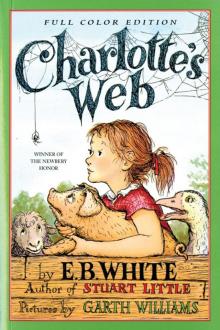 Charlotte's Web
Charlotte's Web Stuart Little
Stuart Little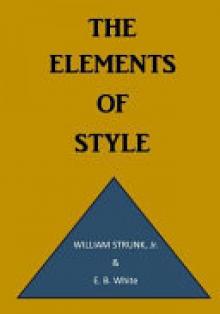 The Elements of Style
The Elements of Style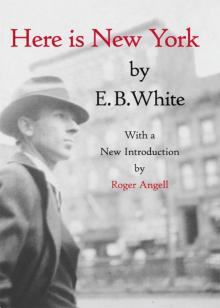 Here Is New York
Here Is New York The Trumpet of the Swan
The Trumpet of the Swan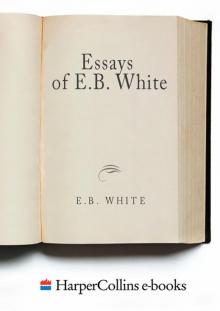 Essays of E. B. White
Essays of E. B. White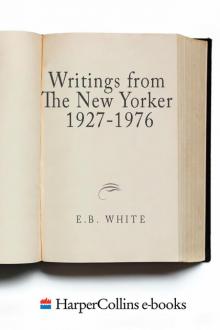 Writings from the New Yorker 1925-1976
Writings from the New Yorker 1925-1976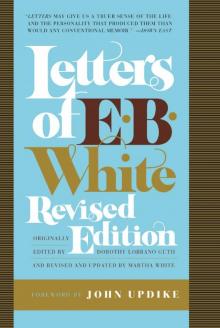 Letters of E. B. White
Letters of E. B. White